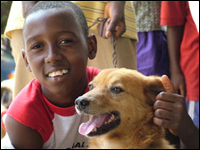Global Efforts to Control and Prevent Rabies
 World Rabies Day is September 28. Human and animal health partners work together to raise awareness for animal rabies control and human rabies prevention.
World Rabies Day is September 28. Human and animal health partners work together to raise awareness for animal rabies control and human rabies prevention.

Photo courtesy of WSPA
Despite being 100% preventable, rabies results in an estimated 55,000 deaths globally each year – approximately one death every 10 minutes. Most deaths are reported from Africa and Asia with almost 50% of the victims being children under the age of 15. Globally, the most important source of human rabies infections is transmission from rabid dogs. Although control of dog rabies has been established by animal vaccination programs in the U.S., dog rabies remains uncontrolled in many regions of the world. Children are often at greatest risk from rabies, as they are most likely to be bitten by dogs or other animals and are often bitten in high-risk areas (such as the head or face).
World Rabies Day – A Global Solution

Rabies education in a classroom in China. Photo courtesy of Heng Dong.
This month marks the second annual World Rabies Day, started by the nonprofit Alliance for Rabies Control and the Centers for Disease Control and Prevention (CDC). The goal of the day is to raise worldwide awareness of the control and prevention of rabies. On the 28th of September, hundreds of thousands of people – from health experts to ordinary citizens – participate in rabies awareness events to advocate for preventing the disease in both human and animal populations. This “One Health” approach, which encompasses both human and animal health, is the core of the World Rabies Day message. World Rabies Day is the only global initiative of its kind and is supported by numerous human and animal health agencies in the public, private and non-profit sectors worldwide.
According to the Alliance for Rabies Control, 74 countries participated in last year’s inaugural World Rabies Day, educating more than 54.3 million people. This year, events are planned throughout the world to increase awareness of rabies and to raise support and funding towards its control and prevention. In the United States, numerous events are taking place, primarily focused at the US Colleges of Veterinary Medicine. These events include vaccination clinics, runs, walks, concerts, festivals and educational seminars.
Reducing Rabies Risk – The US Perspective

World Rabies Day awareness walk in Pakistan. Photo courtesy Naseem Salahuddin.
After exposure to a rabid animal, rabies can be prevented through a series of shots called post-exposure prophylaxis. Recently, CDC announced that human rabies vaccine supplies in the US are limited, and are expected to remain so during 2008 and parts of 2009. This means that efforts must be taken to prevent rabies exposures given vaccine supply limitations.
Rabies prevention starts with the animal owner. Here are a few steps to reduce the risk of rabies exposure:
- Know the facts - Rabies can infect any mammal, but we are most concerned with dogs, cats, ferrets, and other animals that have frequent contact with humans, such as horses. Wild animals, such has raccoons, foxes, and bats, can also have rabies.
- Vaccinate – All dogs, cats and ferrets, and other animals that have frequent contact with humans (such as horses, and livestock at fairs) should be vaccinated against rabies. Pet owners can reduce the possibility of pets being exposed to rabies by not letting them roam free.
- Avoid contact with wild animals – Observe wild animals from a distance. Do not feed or handle them, even if they appear friendly. Wild animals should not be kept as pets. If you see a wild animal acting strangely, report it to animal control. Don’t feed or water your pets outside and keep your garbage securely covered. These items may attract wild or stray animals. Bat-proof your home in the fall and winter.
- Take action if you are bitten – If you are bitten by an animal, immediately wash the wound thoroughly with soap and water and see a healthcare provider. If you were bitten by a wild animal, contact animal control to assist in capturing the animal for rabies testing. If you are bitten by a companion animal, such as a dog, cat, or ferret, it should be examined by a licensed veterinarian to ensure that it is up-to-date on its vaccinations. The pet should be monitored for 10 days. If no illness occurs, then the animal did not have rabies and it is not necessary for you to get rabies post-exposure prophylaxis.
More Information
- Rabies
- World Rabies Day*
- Listen to a podcast, World Rabies Day 2008 (
 6:20 minutes)
6:20 minutes)


